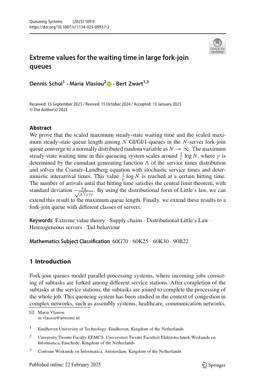2025-03-01
Extreme values for the waiting time in large fork-join queues
Publication
Publication
Queueing Systems , Volume 109 - Issue 1 p. 9:1- 9:26
We prove that the scaled maximum steady-state waiting time and the scaled maximum steady-state queue length among N GI/GI/1-queues in the N-server fork-join queue converge to a normally distributed random variable as N→∞. The maximum steady-state waiting time in this queueing system scales around 1γlogN, where γ is determined by the cumulant generating function Λ of the service times distribution and solves the Cramér–Lundberg equation with stochastic service times and deterministic interarrival times. This value 1γlogN is reached at a certain hitting time. The number of arrivals until that hitting time satisfies the central limit theorem, with standard deviation σAΛ′(γ)γ. By using the distributional form of Little’s law, we can extend this result to the maximum queue length. Finally, we extend these results to a fork-join queue with different classes of servers.
| Additional Metadata | |
|---|---|
| , , , , | |
| doi.org/10.1007/s11134-025-09937-2 | |
| Queueing Systems | |
| Organisation | Centrum Wiskunde & Informatica, Amsterdam (CWI), The Netherlands |
|
Schol, D., Vlasiou, M., & Zwart, B. (2025). Extreme values for the waiting time in large fork-join queues. Queueing Systems, 109(1), 9:1–9:26. doi:10.1007/s11134-025-09937-2 |
|

